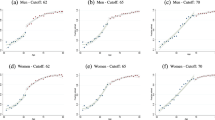Abstract
This paper examines the effect of retirement on individuals’ time spent on home production activities. Using rich longitudinal data from Australia and utilizing recent changes in the Australian Pension system which generate exogenous variation in retirement status, we show a significant increase in time devoted to home production, especially for individuals who voluntarily retire from the labour force. The empirical findings provide further evidence consistent with the majority of retirees successfully smoothing their wellbeing as they make the transition out of the labour force.


Similar content being viewed by others
Notes
These variables are also significant determinants of labour supply decisions
References
Aguiar, M., & Hurst, E. (2005). Consumption versus expenditure. Journal of Political Economy, 113(5), 919–948.
Aguiar, M., & Hurst, E. (2007). Life-cycle prices and production. American Economic Review, 97(5), 1533–1559.
Angrist, D. J. & Pischke, J. S. (2009). Mostly Harmless Econometrics: An Empiricist’s Companion. Princeton University Press, Princeton, New Jersey.
Atalay, K., & Barrett, G. F. (2015). The impact of age pension eligibility age on retirement and program dependence: evidence from an Australian experiment. Review of Economics and Statistics, 97(1), 71–87.
Banks, J., Blundell, R., & Tanner, S. (1998). Is there a retirement savings puzzle? American Economic Review, 88(4), 769–788.
Barrett, G. F., & Brzozowski, M. (2012). Food expenditure and involuntary retirement: resolving the retirement-consumption puzzle. American Journal of Agricultural Economics, 94, 945–955.
Battistin, E., Brugiavini, A., Rettore, E., & Weber, G. (2009). The retirement consumption puzzle: evidence from a regression discontinuity approach. American Economic Review, 99(5), 2209–2226.
Been, J., Susann, R., & Michael H. (2017). Households’ consumption spending and home production responses to retirement: do retirees substitute consumption spending? Mimeo.
Bernheim, D., Skinner, J., & Weinberg, S. (2001). What accounts for the variation in retirement wealth among U.S. households? The American Economic Review, 91(4), 832–857.
Bonsang, E., Adam, S., & Perelman, S. (2012). Does retirement affect cognitive functioning? Journal of Health Economics, 31(3), 490–501.
Bonsang, E., & Van Soest, A. (2015). Home production and Retirement in Couples: a Panel Data Analysis. IZA Discussion Paper No. 9156.
Bradbury, B. (2010). Asset rich, but income poor: Australian housing wealth and retirement in an international context, Social Policy Research Paper No. 41, Australia Government, Department of Families, Housing, Community Services and Indigenous Affairs.
Browning, M., & Crossley, T. F. (2001). The life-cycle model of consumption and saving. Journal of Economic Perspectives, 15, 3–22.
Ciani, E. (2016). Retirement, pension eligibility and home production. Labour Economics, 38, 106–120.
Davidson, R., & MacKinnon, J. (1993). Estimation and Inference in Econometrics. Oxford University Press, New York.
Dunn, R. A. (2015). Labor supply and household meal production among working adults in the health and retirement survey. Review of Economics of the Household, 13(2), 437–457.
Eibich, P. (2015). Understanding the effect of retirement on health: mechanisms and heterogeneity. Journal of Health Economics, 43, 1–12.
Godard, M. (2016). Gaining weight through retirement? Results from the SHARE study. Journal of Health Economics, 45, 27–46.
Haider, S., & Stephens, M. (2007). Is there a retirement consumption puzzle? Evidence using subjective retirement expectations. Review of Economics and Statistics, 89(2), 247–264.
Hamermesh, D. S. (1984). Consumption during retirement: the missing link in the lifecycle. Review of Economics and Statistics, 66(1), 1–7.
Heller-Sahlgren, G. (2017). Retirement blues. Journal of Health Economics, 54, 66–78.
Hurd, M. A., & Susann, R. (2008). The retirement consumption puzzle: actual spending change in panel data. NBER Working Paper 13929.
Hurd, M. D., & Susann, R. (2008). Time-Use in the Older Population: Variation by Socio-economic Status and Health. In R. F. Belli, F. P. Stafford, D. F. Alwin (Eds.) Using Calendar and Diary Methodologies in Life Events Research. Sage Publications, Inc., London, 207–223.
Imbens, G., & Woolridge, J. M. (2009). Recent developments in the econometrics of program evaluation.Journal of Economic Literature, 47, 5–86.
Lemieux, T., & Milligan, K. (2008). Incentive effects of social assistance: a regression discontinuity approach. Journal of Econometrics, 142(2), 807–828.
Luengo-Prado, M. J., & Sevilla, A. (2013). Time to cook: expenditure at retirement in Spain. The Economic Journal, 123, 764–789.
Mazzonna, F., & Peracchi, F. (2012). Ageing, cognitive abilities and retirement. European Economic Review, 56(4), 691–710.
Mazzonna, F., & Peracchi, F. (2017). Unhealthy retirement? Journal of Human Resources, 52(1), 128–151.
Pettersson-Lidbom, P. (2012). Does the size of the legislature affect the size of government? Evidence from two natural experiments. Journal of Public Economics, 98(3–4), 269–78.
Smith, S. (2006). The retirement consumption puzzle and involuntary early retirement: evidence from The British Household Panel Survey. The Economic Journal, 116, C130–C148.
Siminski, P. (2006). The effect of earnings on housework: Pros and cons of HILDA’s time use data items. In ACSPRI Social Science Methodology Conference, 10–13.
Stancanelli, E., & van Soest, A. (2012). Retirement and home production: a regression discontinuity approach. American Economic Review, 102(3), 600–605.
Stock, J., & Yogo, M. (2005). Testing for weak instruments in linear IV regression. In D. W. K. Andrews & J. H. Stock (Eds.) Identification and Inference for Econometric Models: Essays in Honour of Thomas J. Rothenberg. Cambridge University Press, New York.
Acknowledgements
We thank José Ignacio Gimenez-Nadal (the editor) and three anonymous referees for helpful comments. We acknowledge the support of the Australian Research Council (Grant #DP150101718). Author order is alphabetical.
Author information
Authors and Affiliations
Corresponding author
Ethics declarations
Conflict of interest
The authors declare that they have no conflict of interest.
Additional information
Publisher’s note: Springer Nature remains neutral with regard to jurisdictional claims in published maps and institutional affiliations.
Rights and permissions
About this article
Cite this article
Atalay, K., Barrett, G.F. & Staneva, A. The effect of retirement on home production: evidence from Australia. Rev Econ Household 18, 117–139 (2020). https://doi.org/10.1007/s11150-019-09444-3
Received:
Accepted:
Published:
Issue Date:
DOI: https://doi.org/10.1007/s11150-019-09444-3




